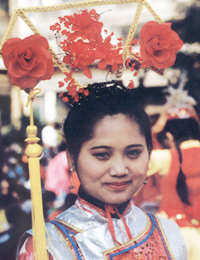 The Manchu, with a population of 9.82 million (by 1990), are mainly distributed in Liaoning, Jilin and Heilongjiang provinces, of which Liaoning has the most Manchus. A small number of the Manchus scatter in Inner Mongolia Autonomous Region, Xinjiang Uygur Autonomous Region, and Hebei and Shangdong provinces.
The Manchu, with a population of 9.82 million (by 1990), are mainly distributed in Liaoning, Jilin and Heilongjiang provinces, of which Liaoning has the most Manchus. A small number of the Manchus scatter in Inner Mongolia Autonomous Region, Xinjiang Uygur Autonomous Region, and Hebei and Shangdong provinces.
Manchu has its own language and letters, which belong to the Manchu-Tungusic Austronesian of the Altaic Phylum. Manchu letters were created in the 16th century on the base of Mongolian letters. With more and more Manchus settling in the Central Plains since the Qing Dynasty (1644-1911), the economic and cultural exchange between the Hans and Manchus became more and more frequent and the Manchus gradually adopted the Han language.
Manchu history can be traced back to the Nuzhen people who lived 2,000 years ago. They were the earliest ancestors of the Manchu. In the Liao (916-1125), Song (960-1279), Yuan (1271-1368) and Ming (1368-1644) dynasties, they were called "Nuzhen". At the end of the 16th century, Nurhachi unified the tribes of Nuzhen and a new ethnic group -- Manchu -- came into being. With the founding of the Qing Dynasty in 1644, the Manchu reached its golden age. After the 1911 Revolution, this ethnic minority was named the Manchu ethnic minority.
Like the Han people, most Manchus are engaged in agriculture-related jobs. They also raise tussah silkworms. Most of the Manchu people in cities, who are better educated, are engaged in traditional and modern industries.
The traditional costumes of a Manchu man are a narrow-cuffed short jacket over a long gown with a belt at the waist to facilitate horse-riding and hunting. Manchu women used to wear loose-bodied Cheongsams and embroidered shoes. In the past, Manchu men wore their hair long. They braided their hair and let the braids droop behind their heads. During the Qing Dynasty (1644-1911) the queue became the standard fashion throughout China, eventually becoming a political symbol of the dynasty. Women coiled their hair on top of their heads and wore earrings and headgear.
Following the Manchus' southward migration, the common people came to wear the same kind of dress as their Han counterparts, while the Manchu Cheongsam was adopted by the Han women generally.
Most Manchus believed in Shamanism in the past, thinking that there were many gods commanding the world. Now this belief has faded away. The Manchu and the Han basically share the same festivals and holidays such as the Spring Festival, the Duanwu Festival and the Mid-autumn Festival, although there are still some differences in terms of celebrating ceremonies. During festivals, the Manchus always hold various traditional sports activities, of which the most common sports are Pearl Ball and skating.
